Viccotto, the great Marche gastronomic mystery
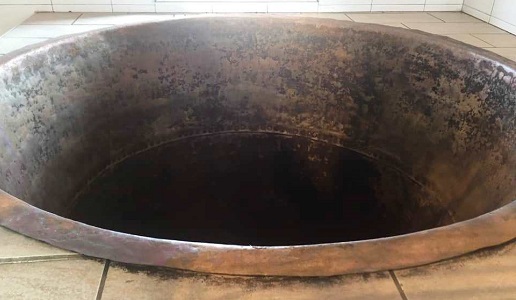
By law this is not a wine but a “traditional product” but in the right hands it can be an authentic wine gem.
“Viccotto”, a contraction of “vino cotto” (cooked wine), is a Marche gastronomic mystery. Although penalized by, frankly, its modest average quality, the fact that it is almost always served at the wrong temperature (it should be cool like a fine white wine) and, above all, that it is placed in a questionable food category (by law it is not a wine but a “traditional product”), in the right hands it can be truly exceptional.
A great Viccotto can achieve remarkable levels of complexity and capacity to please, while retaining a distinctly rustic, homey nature, full of warmth and a black and white physiognomy that can tell you more about Italy’s post-war rural reality than a chapter of Mario Soldati’s book Vino al Vino.
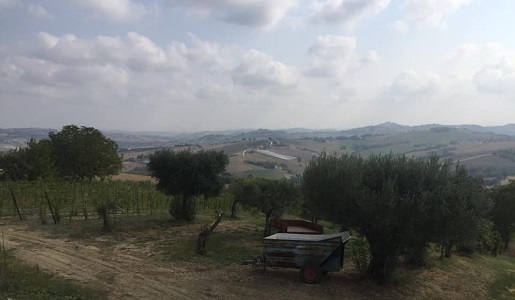
A product of the region’s “belly”, this has all the Marche characteristics found the silent and, for the most part, unknown Macerata hinterland – where people are diffident, serious and resistant to change, including when it comes to promoting their products. The historic production hub of Viccotto is in Loro Piceno, 15 minutes from Macerata, where its production has been documented since Medieval times.
It is a bit like Sherry, because Viccotto matures in wood and the wines are always blended, and a bit like vinegar, because the barrels used are never completely cleaned and always have some decades-old lees left in them to serve as a starter. And it is also a bit a creation of tenant farmers, because farm owners would leave their sharecroppers the grapes that were less ripe and less healthy and thus unfit for traditional winemaking. Viccotto differs from Madeira, for which the finished wine is heated, because the must is delicately brought to a boil – and thus not simply cooked. This is why Viccotto is not legally categorized as a wine.
There are not many quality producers of this artisanal, “dirty Marche” product (there is also a small production in the Abruzzo region). The worst Viccotto is the result of quickly boiling must made from cheap grapes purchased in southern Italy, while the best involves slow cooking and using grapes from dense, well-exposed vineyards and this because a great Viccotto above needs to be made from ripe grapes.
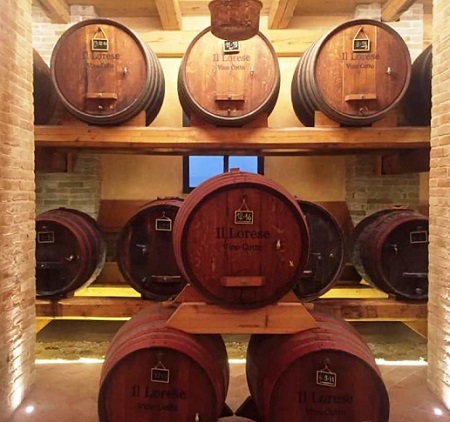
Simone Forti, owner of the Il Lorese estate, is one of the best producers of Viccotto and not just in the zone of Loro Piceno. “In our vineyard we have the area’s typical varietals: Sangiovese, Montepulciano and Trebbiano Toscano. We cultivate them as we would for any other wine, also in view of the fact that in the near future the same vines will begin to produce “normal wines”.
DoctorWine: What are the fundamental steps towards making a quality Viccotto?
Simone Forte: First of all, you have to use only free-run must and this free-run must has to boiled delicately, otherwise the Viccotto will taste like burnt caramel. Then the room where the boiling takes place needs to be well-aerated, otherwise the Viccotto will absorb excessive notes of smoke from the burning wood. A hint of smoke, however, is needed to give it that homespun touch.
DW: How long does the must need to cook?
SF: Usually, 16-17 hours to achieve 29-31° Babo, starting from 19°, and cooking always takes place in 5hl vats. During cooking, not only do the sugars become more concentrated but the must loses around half its weight. But the most delicate moment is during alcoholic fermentation.
DW: Why is that?
SF: Direct cooking kills the yeasts that are naturally found in the must and thus a catalyst is needed to kick-start fermentation, usually fresh, uncooked must in which spontaneous fermentation has already begun. Fermentation then needs to be constantly monitored, because its interruption is very common, and if you do not immediately add some fermentation catalyst, the final product will have a horrible volatility, making it more like a balsamic vinegar than a Viccotto.
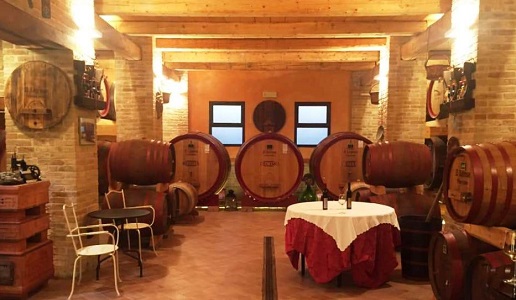 DW: Thus in cooler wineries care must be taken to avoid the risk that fermentation does not take place at all and what is produced is sapa (ed.note: a syrup made from directly boiling the must without fermentation to create a condiment) rather than a Viccotto.
DW: Thus in cooler wineries care must be taken to avoid the risk that fermentation does not take place at all and what is produced is sapa (ed.note: a syrup made from directly boiling the must without fermentation to create a condiment) rather than a Viccotto.
SF: Exactly. Fermentation continues until January and always in large barrels. Once completed, a rough decanting is performed, leaving the Viccotto on the lees after which it is transferred into barrels that have decades-old lees which act as a starter, as with vinegar, and provide nutriment and complexity to the product. A light filtering take place before bottling Lorese, while the select Viccotto is unfiltered.
DW: What are Viccotto’s biggest problems?
SF: There are two major ones: its average quality and the lack of production regulations. It’s a shame because a top Viccotto is extraordinary and I sincerely believe that I and two or three other producers are proving this. There is nothing better to pair with cookies or to consume as an after-dinner drink.
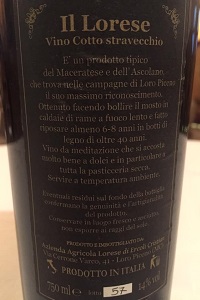 Vino Cotto Stravecchio Il Lorese n.m.
Vino Cotto Stravecchio Il Lorese n.m.
92/100 - € 16,50 (0,750 lt.)
Made from Sangiovese, Montepulciano and Trebbiano Toscano grapes. The must is cooked directly over the fire and matures for some seven years using the Solera Method. A deep, mahogany color with a yellow edge and an aroma of prune and caramel and sweet licorice. The sweet and full-bodied mouthfeel is vibrant thanks to the volatility which remains locked in. A sweet finish, boldly balsamic yet also fruity with notes of prune, extremely long. The aftertaste has notes of unsweetened coffee.
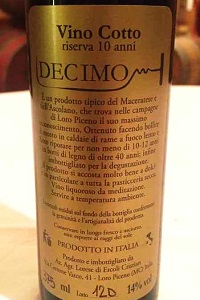 Vino Cotto Riserva Dieci Anni Decimo n.m.
Vino Cotto Riserva Dieci Anni Decimo n.m.
94/100 - € 21 (0,375 lt.)
Made from Sangiovese, Montepulciano and Trebbiano Toscano grapes. The must is cooked directly over the fire and the Viccotto matures for some 10 years in medium-sized barrels using the Solera Method. A deep, mahogany color with a yellow edge and copper reflections. A bouquet of iodine, dried prune, vanilla and unsweetened coffee. The sweet and vibrant mouthfeel has exceptional persistence and an aftertaste of unsweetened coffee and spice with a persistence that lasts minutes. A monumental Viccotto with great complexity.
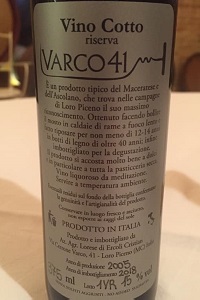 Vino Cotto Riserva Varco 41 n.m.
Vino Cotto Riserva Varco 41 n.m.
96/100 - € 22 (0,375 lt.)
Made from Sangiovese, Montepulciano and Trebbiano Toscano grapes. The must is cooked directly over the fire and the Viccotto matures for some 14 years in medium-sized barrels using the Solera Method. A deep mahogany- barley color and a coffee and chestnut honey aroma, balsamic, more austere and peevish than the Decimo and a tad less complex. The mouthfeel is full-bodied, sweet and vibrant and finishes on notes of licorice, chestnut honey and dried fruit. The usual persistence is pleasingly bitter and lasts for many minutes. This could hold its own against a great Madeira Malmsey. Fantastic.
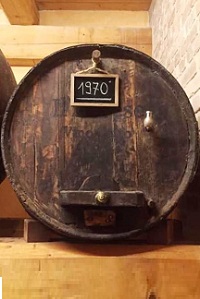 Vino Cotto 1970 (from the barrel)
Vino Cotto 1970 (from the barrel)
97/100 – the price is still not available
Made from Sangiovese, Montepulciano and Trebbiano Toscano grapes. The must is cooked directly over the fire and has been maturing in small barrels since the winter of 1971. A coffee color with mahogany reflections and a somber bouquet with fireplace ash notes and those of coffee powder and leather. The mouthfeel is very sweet, violently savory and finishes on notes of burnt barley, fireplace ash and iron. This is like looking at Cesare Peruzzi’s painting “La Polenta Marchigiana” (which you can see Palazzo Buonaccorse in central Macerata). No date has been set for its bottling and market debut. Spine-tingling.

 Italiano
Italiano











